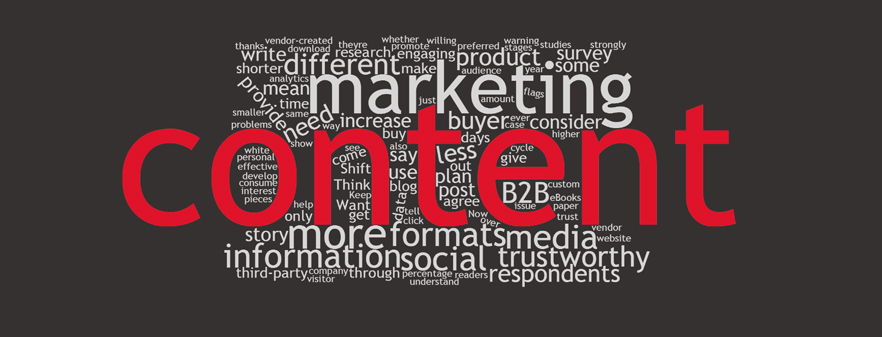How to Deal with 3 Major Shifts in Content Marketing

Content marketing just keeps getting more important. In the beginning, it was because fresh content helped visitor engagement and increased SEO rankings. It was all about writing good content with lots of relevant keywords. Now that content marketing is well and truly entrenched as a cornerstone of digital marketing plans, the bar is moving up. If you’re wondering whether you should build content development capability, here is what the numbers look like for B2B companies:
- The average amount a company spent in 2012 on content marketing was 33% of their marketing budget, up from 26% in 2011*
- 54% of B2B marketers plan to increase content marketing spend over the next 12 months*
- 34% of marketers named content marketing as their “leading focus” in 2013 -- nearly double the responses from the previous year **
* 2013 B2B Content Marketing Benchmarks by the Content Marketing Institute and MarketingProfs. ** 2013 State of Content Marketing by Copypress
Before making plans for more content marketing, take some time to consider how the dynamics of content have changed – thanks to social media. Think about it. You write a great blog post or a feature story on your website. How do you get the word out? In olden days (and in Internet time, this means a couple of years ago) you might send out an email newsletter to customers and prospects. Now, you use social media to promote and link back.
-
Shift #1: Less Tolerance for “Sales Pitch” Content
Thanks to social media, you have wider reach, but it also means that if an increasing percentage of traffic comes from social media, you need to respect the key principle of social media etiquette: it’s not about you.
The majority of your blog posts and stories need to show you understand and care about your target community’s issues and goals, their problems and shared interests.
Does this mean you can’t ever promote your products and services on your website? Of course not. It just means you need to plan out a content calendar that contains a higher percentage of information that adds value for your audience versus content that’s directly about product. Want ideas on what sort of content is valuable to your audience? Keep reading.
-
Shift #2: Faster Assessment of Content Trustworthiness
According to research from DemandGen’s 2013 B2B Content Preferences Survey:
- 98% of survey respondents say they place a higher emphasis on the trustworthiness of the content they view
- 92% of respondents say they are willing to consider vendor-created content as trustworthy, but only 29.7% of this same group actually agrees with this statement (that vendor-created content is trustworthy)
What’s so new about wanting trustworthy information, you ask?
The real issue is that if buyers see warning flags these days, they’re quicker to click away. While B2B buyers rely on content to make decisions, they must sift through more content than ever, and have less time to assess the trustworthiness of the information.
What are some of those warning flags? How can you increase the buyer’s trust in your content?
- Less about product, more about problem-solving:
62% of respondents in the above survey strongly agree there is too much content about technology or specifications and not enough about how the product solves business problems. Write content that makes your readers more effective, smarter, or in tune with trends. This will help you over the long run to develop trust in your brand. - Show us the data:
63.2% of respondents strongly agreed that they wanted to see the data and research behind claims made by vendors. Deliver information more transparently. - Third-party authorship:
When vendor content is authored by or co-authored with a third-party publication or analyst, 49% of respondents say they ‘frequently’ give high credibility to this type of content; 43% say ‘sometimes’. Consider engaging a third-party to conduct a custom survey or write a white paper. - Lower barriers to download:
B2B decision-makers are less and less inclined to provide personal information in order to access content. For white papers, eBooks and case studies, only 9% - 11% of buyers are willing to register some personal information. Webinars came in at only 20% willingness. Consider minimizing the amount of data you collect for registration to download.
-
Shift #3: Consume Content in More Formats
When visitors come to your site, they’re at different stages of readiness to buy. Marketing professionals understand the need to provide content that addresses different stages of the product research and buying cycle. But given that readers these days exhibit shorter attention spans, you also need to:
- Provide content in smaller chunks: shorter blog posts, case studies, and articles
- Provide content in different formats: infographics, podcasts, eBooks
You can lure buyers more effectively by giving them different ways to consume content. Spread the same messages and information across different formats and use the shorter versions as springboards to longer formats. Think of them as ‘sound bites’ that attract interest. Create some content pieces in smaller and more digestible formats with calls to action (CTA) that click through to full-length pieces. Think in terms of a series of marketing content that tells a complete story, using different formats along the way to support the buying cycle.
Finally, use Google analytics and social media analytics to measure as you go. Evaluate which posts/stories are getting the most traction and being amplified through social media, which pages give you best engagement, whether user comments tell you which buttons you’ve managed to push. Discover any common denominators when it comes to topics or preferred formats.


